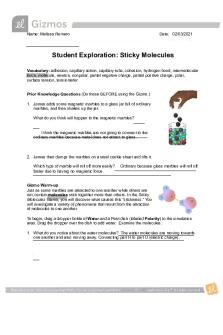Small molecules transmitters PDF

| Title | Small molecules transmitters |
|---|---|
| Author | Namrah Afzal |
| Course | Physiology |
| Institution | The University of Lahore |
| Pages | 2 |
| File Size | 62.3 KB |
| File Type | |
| Total Views | 146 |
Summary
table of neurotransmitter and small molecular transmitters...
Description
Small molecules transmitters acetylcholine
effect Mostly excitatory, sometimes inhibitory
Origin
Norepinephrine
Mostly excitatory, sometimes inhibitory
Site of action Large pyramidal cells Neurons of basal ganglia Preganglionic fibers of autonomic nervous system Post-ganglionic fiber of parasympathetic and sympathetic nervous system Cells bodies in brain stem and hypothalamus Nucleus locus ceruleus of pons Post-ganglionic nerve fibers of sympathetic nervous system Neurons of Substancia niagra
Dopamine (low in Parkinson’s disease) Glycine
Inhibitory
Inhibitory
Synapse of spinal cord
GABA (gammaaminobutyric acid)
Inhibition
Glutamate
Excitation
Serotonin
Inhibitor
Basal ganglia Spinal cord Cerebellum Cortex Pre-synaptic terminals of sensory pathway Cerebral cortex Nuclei of median raphe of brain stem
Widespread areas of the brain
Striatal region of basal ganglia
Spinal cord Brain stem Hippocampus Synapse of spinal cord
Neuronal cells Gilial cells
Inhibitory pathways of spinal cord Higher regions of the nervous system
Nitric oxide
Inhibitory
Cortex Endothelial cells
Periphery parasympathetic nerve endings Vagus nerve
Small molecule neurotransmitter Rapid acting Synthesized in cytosol of soma
Absorbed into vesicles by active transport and stored Effect is to cause increase or decrease in conductance
Vesicles containing small transmitters are continually recycled Example: Ach synthesized in the pre-synaptic terminal membrane Acetyl Coenzyme A + Choline → Ach (choline acetyl transferase Ach recycled in the synaptic cleft Ach → Acetate + choline (cholinesterase
Nitric oxide Rapid acting small transmitter Synthesized at the presynatic membrane terminal as and when needed
Is not stored in vesicles and released instantly after synthesis Has inhibitory effect on nervous system Does not alter the membrane potential but changes intracellular metabolic function
Neuropeptides
Synthesized as integral part of large proteins by ribosomes and neuronal cell body → endoplasmic reticulum → golgi apparatus 1. Neuropeptides broken into smaller fragments 2. Packaged into vesicles Vesicle then moves to Vesicle is autolyzed and not reused Effect if more prolonged, as they are highly potent...
Similar Free PDFs

Small molecules transmitters
- 2 Pages

Small oscillations
- 22 Pages

Sticky Molecules- Gizmos Answers
- 7 Pages

Organic Molecules Lab Report
- 9 Pages

Web Quest - Organic Molecules
- 4 Pages

Molecules of Life: worksheet
- 2 Pages

Sticky Molecules Sehandin
- 8 Pages

Q-molecules answers QUESTIONS
- 6 Pages

Giant covalent molecules
- 7 Pages

Organic Molecules BIOL1P91
- 16 Pages

Small Business Owner Interview
- 3 Pages

entrepreneurship and Small Business
- 55 Pages

A Small Place
- 10 Pages

PFRS for Small Entities
- 104 Pages
Popular Institutions
- Tinajero National High School - Annex
- Politeknik Caltex Riau
- Yokohama City University
- SGT University
- University of Al-Qadisiyah
- Divine Word College of Vigan
- Techniek College Rotterdam
- Universidade de Santiago
- Universiti Teknologi MARA Cawangan Johor Kampus Pasir Gudang
- Poltekkes Kemenkes Yogyakarta
- Baguio City National High School
- Colegio san marcos
- preparatoria uno
- Centro de Bachillerato Tecnológico Industrial y de Servicios No. 107
- Dalian Maritime University
- Quang Trung Secondary School
- Colegio Tecnológico en Informática
- Corporación Regional de Educación Superior
- Grupo CEDVA
- Dar Al Uloom University
- Centro de Estudios Preuniversitarios de la Universidad Nacional de Ingeniería
- 上智大学
- Aakash International School, Nuna Majara
- San Felipe Neri Catholic School
- Kang Chiao International School - New Taipei City
- Misamis Occidental National High School
- Institución Educativa Escuela Normal Juan Ladrilleros
- Kolehiyo ng Pantukan
- Batanes State College
- Instituto Continental
- Sekolah Menengah Kejuruan Kesehatan Kaltara (Tarakan)
- Colegio de La Inmaculada Concepcion - Cebu

